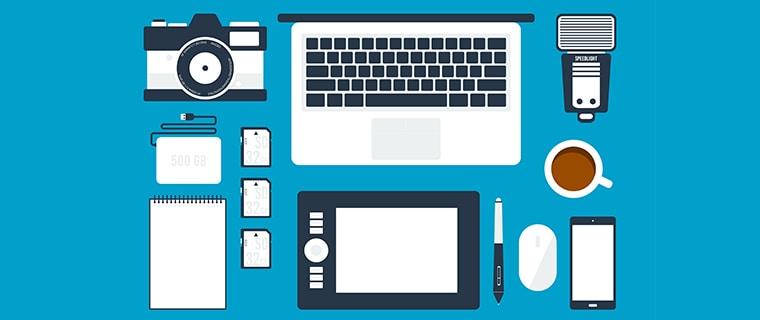How to run an RFP for Digital Asset Management
Jul 23, 2019

In part two of our series about managing a Request for Proposal (RFP) process, this week we look at the process for launching an RFP to find a Digital Asset Management vendor. If you’re interested in reading more about RFP process, part one can be found here: ‘Crafting a Superior RFP Response as a Supplier’.
How to Submit an RFP for a DAM Project
If you’ve made a business case for a digital asset management system, and received the necessary company buy-in and budget, the next thing you’ll need is to evaluate potential vendors. It’s only natural that every vendor will tell you their system is the best. However, unfortunately, that is not always the case. It’s vital to ensure that your selected DAM vendor understands your industry, your company and your specific requirements.
It’s not sufficient to choose a vendor purely based on a list of selected criteria. As part of the procurement process for DAM, you’ll need to create and send a request for proposal (RFP). An RFP will detail your pain points and how you hope they will be solved. Getting the technical details right is fundamental, as well as ensuring your request reflects the real needs of your business. Understanding the finer points of submitting an RFP can make all the difference to your vendor selection.
What is The Difference Between an RFP, RFI, RFQ and RFT?
As procurement terms are very similar, they can often be used interchangeably and, unfortunately, incorrectly. It’s worthwhile making sure you understand the difference between the phrases to ensure you are submitting the right documents for the right purposes. The principal procurement terms include:
- Request for Proposal (RFP) – this is used when you know you have a problem, but you aren’t sure how to solve it. It is the most formal of the procurement processes.
- Request for Information (RFI) – this is used when you think you know what system or product you need, but require further information from potential vendors.
- Request for Quote (RFQ) – this is used when you know what you need but require information on how vendors will meet your requirements and how much it will cost.
- Request for Tender (RFT) – this is used as an opportunity for potential vendors to submit an offer for goods or services against a tender.
Once you understand which process you need, you can focus on learning how to effectively use each one. Based on the above, in the case of procurement for a DAM system, you’re going to need to create an RFP.
The RFP Preparation Steps
If you are going to successfully find and work with any vendor, refining your RFP process is a must. This will prevent you from spending extra time and money finding companies that aren’t suitable. Get the preparation right for creating your RFP and you’ll be ahead of the game, and much more likely to find the right vendor for your business. There are four key stages to preparing your RFP:
- Problem Analysis
First things first, you need to outline the problem that a DAM would fix. These are all the issues that you face within your organisation that could be solved by having a new system in place. The more detail you’re able to include in your RFP around your pain points, the easier it is for vendors to understand how they can help.
User stories can add a lot of weight to your problem analysis. They offer real-world examples of how you see your company using a digital asset management system. The stories enable you to describe what you are trying to accomplish, why it’s important to your business, and who is involved. Including around three to five stories should allow you to define how DAM can solve the problems you’re facing.
- Functionality Check-List
Once you’ve defined the problems that you’re facing, you’ll be in the perfect position to list the features and functionality you’ll need to solve them. It’s worthwhile listing everything you can think of and then cutting it back from there. If you try to solve absolutely everything, you will dilute each of the solutions.
To help prioritise your functionality check-list, consider using the MoSCOW system. Defining which features are a must, should, could or would will make you much more likely to succeed. Having a system that handles your top priorities incredibly well is better than having more handled through insufficient workarounds.
- Define the Project Scope
This is where you build on your problem analysis and brief company introduction. You will want to write a clear outline of what you are trying to achieve. To accurately describe the projects, make sure you include your business objectives, DAM objectives and specific DAM requirements. Keeping the project scope at the heart of your RFP will ensure you focus on finding a DAM system that solves your problems.
- Vendor Review and Shortlist
While creating a refined RFP will help you select the right vendor, you first have to create a distribution plan to ensure it ends up in the right hands. Chances are, if you’ve been considering a DAM for some time, you have several vendors in mind. However, each vendor will have its own strengths, weaknesses and limitations. Make sure you scan the market for vendors that could match your requirements, focusing on those with specific industry experience. Be wary not to cast your net too wide though, as it could make for an awkward and complicated review process.
Creating the RFP Document
Once you’ve done all of your homework and preparation, it’s time to create the RFP document that you’ll send to prospective vendors. You’ll need to include the following information:
- RFP Structure
You will already have most of the details that you need to include in your RFP from your preparation stage. Explaining everything upfront in your FRP will enable potential vendors to know exactly what you need and why. The structure of your RFP should include:
- Executive Summary – a succinct description of the reason for the project and what success will look like to you
- Purpose / Mission Statement – a summary of your use-cases and pain points that you have built from your problem analysis
- Company Background – an explanation of what you do and who you serve as a target market.
- Confidentiality Statement – advising the vendor that all information in the RFP is confidential
- Disclaimer Statement – advising the vendor that the RFP does not imply any commitment
- Statement of Work (SOW) – a high-level outline of specific deliverables and project requirements
- Project Goals – identify what you hope to accomplish and what success will look like to you.
- Project Scope – what does the system need to incorporate in order to deliver. Defining your project scope ensures there are no surprises later on.
- Functionality Check-List – include your prioritised list of features and functionality to help focus on what is most important to your business
- Technical Requirements – to implement a DAM system successfully, you’ll need to outline integrations you’ll need, asset migration requirements and scalability and hosting specifications.
- Target Schedule – you may not have strict deadlines at this point, but stating a target schedule enables vendors to confirm whether they have the resources to undertake the job within a given timeframe.
- Budget Constraints – being upfront with your budget helps vendors give realistic responses.
- Vendor Requirements – explain exactly what you’re looking for in a DAM partner and outline what matters most to you and your business. Cultural fit and customer service can be equally as important as functionality.
- Questions to Include
Including questions in your RFP allows you to find out more information about what each DAM vendor offers. With this information, it’s easier to see if each one meets your requirements. The fundamental point here is making questions as specific as possible. There is no limit to the number of questions you can ask. Some questions you may want to consider include:
- What are the DAM system’s key features?
- What are the system’s workflow and creative project management capabilities?
- Which features demonstrate a commitment to user experience?
- What is the project planning methodology for DAM implementations?
- What is the deployment process and QA approach?
- What assets are supported?
- What are the expected timescales for development?
- What is the development roadmap for the DAM system?
- What does the code deployment process look like?
- What sets them apart from their competitors?
- How does the system manage digital asset organisation and classification?
- Is the solution cloud or on-premise? If cloud-based, how does it maintain its servers?
- What security protocols does the company follow?
- What integrations are supported, and what will be supported in the future?
- What reporting and analytics are available?
- What training materials will be available during and after implementation?
- What consulting options are available for implementation?
- What is the pricing structure?
- Supporting Content
To support your RFP, you will want to provide examples of content. This ensures that any potential vendor, and their intended solution, can support the file types that your organisation works with. If you send a selection of your own files, the vendors can upload them into their system as part of the RFP process, ensuring their system does what you need it to do. Make sure you include images, videos and document files. This will help you have a better understanding of what the real-life experience will be for your end-users.
The Process for Vendor Response
As part of your RFP you will need to specify when it is due back, and where and how you would like to receive answers to questions and the RFP packages. You should give a date for the last day you will accept questions and clarifications, when you will provide responses to those questions and when you will make your shortlist. An estimated timescale might look like:
- Week 1 – questions collected from all prospective vendors.
- Week 2 – responses compiled and distributed
- Week 3-4 – proposal deadline when completed RFP packages are due
- Week 5-6 – processing responses and establishing evaluation criteria
- Week 7 – shortlisted vendors announced
- Week 8-9 – onsite demo day
- Week 10 – selected vendor announced
You’ll also need to specify within your RFP what you expect as responses. You will want to request things such as a system architecture diagram, approximately three case studies and API documentation. It’s wise to insist that they should only be in PDF format along with the RFP response itself.
By putting together a comprehensive RFP document, you’re much more likely to get the information you need from prospective vendors. By then evaluating them against set criteria, you will be able to make a much more informed decision. Implementing the right DAM solution for your business is vital if you are to get the most out of your digital assets.





